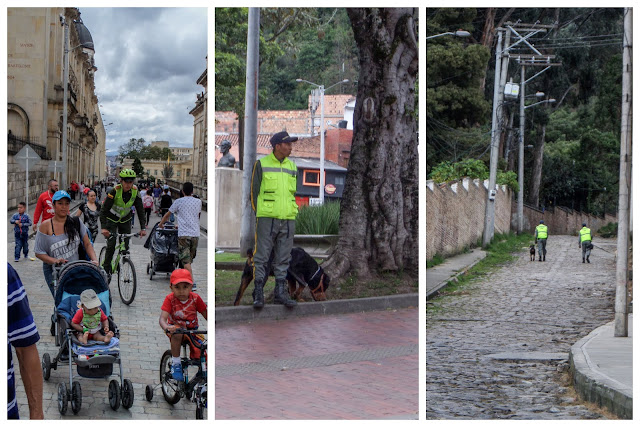1. On Sundays, Bogotá closes over 100 kms of its road to vehicular traffic, and in the left photo a Policeman joins the throngs.
2. Many policía have dogs accompanying them.
3. Policemen patrolling a vacant street.
Graffiti
In recent years, graffiti in Bogotá has not only been condoned, but the city even commissions grafiteros to adorn walls. In fact, in order for graffiti to be legal, the artist needs the permission of the owner of the wall. There are still "taggers," of course, those who scrawl on walls, but most of the graffiti is a work of art.
On the Sunday we were in Bogotá, I went on a free 2 1/2 hour graffiti tour with Bogotá Graffiti, mostly through the Candelaria area. It was a fascinating tour, and the guide not only covered the stories behind the artwork and the grafiteros, but also touched on some of the political and social problems that Bogotá faces.
Statues are in unexpected places in Candelaria. In the bottom photo, the street sign is incorporated into the cat's face. The right mural is by Crisp, the founder of Bogotá Graffiti, who says that the city's policy regarding graffiti enables artists to work during the day, thus producing more elaborate works, (www.fushion.net 3/3/15).
The bottom scene is political, rare for the artworks, because the city does not condone them. In the bottom drawing, the man with the pig's snout "ridicules the capitalist greed that ruled the armed conflict."
The bottom left mural asserts, "Todos contamos," (We all count.) This refers to the fact that many of the impoverished people living in rural Colombia have to travel up to 20 hours by bus just to cast their votes! The middle drawing is also political, with the caption, "Trabajo sucio, pero trabajo" (Dirty work, but still work.) This alludes to the poor people who sort through the garbage in the city. The bottom right mural is composed with "tag proof" paint. It's a glossy finish to which spray paint won't adhere and can easily be washed off.
Edificios
There are many imposing colonial buildings in Bogotá, including Iglesia Carmen, top left, and the buildings surrounding Plaza Bolívar. The plaza is a main tourist attraction. The Cathedral (lower right) is about 200 years old, and the square throngs with people, especially on Sunday afternoons.
The statue (lower left) is of Símon Bolívar (1783-1830), who was instrumental in the formation of Venezuela, Peru, Colombia, Panama, and Ecuador as independent states (Wikipedia).
Making a Buck
And what would a Latin American city be without vendors and entertainers hustling for a buck?
Care for a llama ride anyone? The woman in the bottom right is selling corn, to be used as pigeon food, left.
The "statues", photos 3 and 4, danced after you donated to the cause.
Teleferico

The teleferico rises 800 meters up Mount Monseratte, to an elevation of 3152 m above sea level. It completes the trip in only 4 minutes, hauling up to 40 passengers at a time, and provides a panoramic view of the city.
The Other Side of Bogota

Clockwise, from top left: 1. Most of the streets in the historical district are clean, but there are occasional heaps of trash.
2. If you look closely, you can make out a man passed out, leaning against the wall behind the trash container. Homelessness seems to be a severe problem. I saw countless men passed out, even in the afternoon.
3. The police were brutally throwing women into the back of the van; for what, I don't know, but maybe because they were homeless. The area know as "The Bronx," just a few blocks south of the presidential palace, was a haven for homeless addicts and crime bosses until police raided it last May. Of course, that only forced the addicts to find homes somewhere else.
4. This man was sleeping, in a pile of garbage, at 1 p.m., right near Carrera 7, the main pedestrian street in Candelabria.
Hasta Luego
Colombia exceeded our expectations in almost every way, but especially the people's kindness. I highly recommend a trip to this wonderful country.
| 











Good post John!
ReplyDeletethanks Neil. How's it going with you and Eldeen? Are you getting away this winter?
DeleteThanks once more, John. Interesting storyline and wonderful images of the people and the area. I enjoy your travels. Arlene B.
ReplyDeleteThanks Arlene.
DeleteA very interesting blog as usual.
ReplyDeleteGraffiti: we did the same thing in Budapest, in the old jewish quarter, but you have more in Bogota.